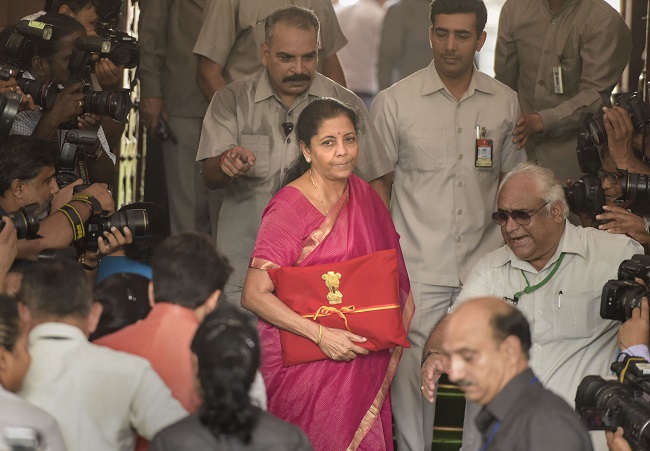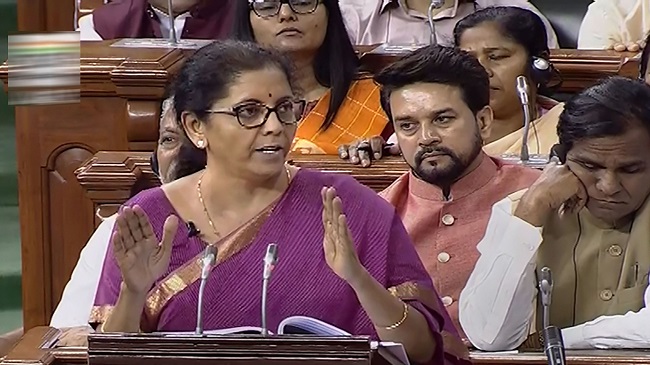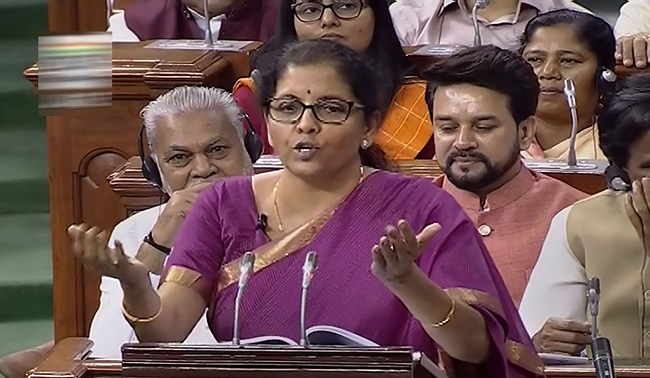
Indian Finance Minister Nirmala Sitharaman presented the country’s General Budget for financial year 2019-20. Excerpts from her speech.
“Our economy was at approximately US$ 1.85 trillion when we formed the Government in 2014. Within 5 years it has reached US$ 2.7 trillion. Hence, it is well within our capacity to reach the US$ 5 trillion in the next few years. In the interim Budget of 2019-20 presented in February 2019, we gave ourselves a Vision for the Decade. I flag here the ten points of our Vision laid before us:
- Building physical and social infrastructure;
- Digital India reaching every sector of the economy;
- Pollution free India with green Mother Earth and Blue Skies;
- Make in India with particular emphasis on MSMEs, Start-ups, defence manufacturing, automobiles, electronics, fabs and batteries, and medical devices;
- Water, water management, clean Rivers;
- Blue Economy;
- Space programmes, Gaganyan, Chandrayan and Satellite programmes;
- Self-sufficiency and export of food-grains, pulses, oilseeds, fruits and vegetables;
- Healthy society – Ayushman Bharat, well-nourished women & children. Safety of citizens;
- Team India with Jan Bhagidari. Minimum Government Maximum Governance.”
“The Indian economy will grow to become a $3 trillion economy in the current year. It is now the sixth largest in the world. Five years ago, it was at the 11th position. In Purchasing Power Parity terms, we are in fact, the 3rd largest economy already, only next to China and the USA.”
“Connectivity is the lifeblood of an economy. The Government has given a massive push to all forms of physical connectivity through Pradhan Mantri Gram Sadak Yojana, industrial corridors, dedicated freight corridors, Bhartamala and Sagarmala projects, Jal Marg Vikas and UDAN Schemes. While the industrial corridors would improve infrastructure availability for greater industrial investment in the catchment regions, the dedicated freight corridors would mitigate the congestion of our railway network benefitting the common man. The ambitious programme of Bharatmala would help develop national road corridors and highways, while Sagarmala would enhance port connectivity, modernization and port-linked industrialization. If Sagarmala is aimed at improving the infrastructure for external trade, equally it is the poor man’s transport too. Waterways are proven as a cheap mode of transport. The Jal Marg Vikas project for capacity augmentation of navigation on National Waterways is aimed at smoothening internal trade carried through inland water transport. These initiatives will improve logistics tremendously, reducing the cost of transportation and increasing the competitiveness of domestically produced goods.”

“India’s first indigenously developed payment ecosystem for transport, based on National Common Mobility Card (NCMC) standards, was launched by Hon’ble Prime Minister in March, 2019. This will enable people to pay multiple kinds of transport charges, including metro services and toll tax, across the country. This inter-operable transport card runs on RuPay card and would allow the holders to pay for their bus travel, toll taxes, parking charges, retail shopping and even withdraw money.”
“Phase-II of FAME Scheme, following approval of the Cabinet with an outlay of Rs 10,000 crore for a period of 3 years, has commenced from 1st April, 2019. The main objective of the Scheme is to encourage faster adoption of Electric vehicles by way of offering upfront incentive on purchase of Electric vehicles and also by establishing the necessary charging infrastructure for electric vehicles. Only advanced battery and registered e-vehicles will be incentivized under the Scheme with greater emphasis on providing affordable & environment friendly public transportation options for the common man.”
“We need to develop our inland waterways to shift a significant portion of inland cargo movement from road and rail. This Government envisions using the rivers for cargo transportation, which will also help to decongest roads and railways. As part of the Jal Marg Vikas Project for enhancing the navigational capacity of Ganga, a multi modal terminal at Varanasi has become functional in November 2018 and two more such terminals at Sahibganj and Haldia and a navigational lock at Farakka would be completed in 2019-20. The movement of cargo volume on Ganga is estimated to increase by nearly four times in the next four years. This will make movement of freight, passenger cheaper and reduce our import bill.”
“It is estimated that Railway Infrastructure would need an investment of Rs 50 lakh crores between 2018-2030. Given that the capital expenditure outlays of Railways are around Rs 1.5 to 1.6 lakh crores per annum, completing even all sanctioned projects would take decades. It is therefore proposed to use Public-Private Partnership to unleash faster development and completion of tracks, rolling stock manufacturing and delivery of passenger freight services.”
“For ease of access to credit for MSMEs, Government has introduced providing of loans upto Rs 1 crore for MSMEs within 59 minutes through a dedicated online portal. Under the Interest Subvention Scheme for MSMEs, Rs 350 crore has been allocated for FY 2019-20 for 2% interest subvention for all GST registered MSMEs, on fresh or incremental loans.
“It is right time to consider increasing minimum public shareholding in the listed companies. I have asked SEBI to consider raising the current threshold of 25% to 35%.”
“FDI inflows into India have remained robust despite global headwinds. Global Foreign Direct Investment (FDI) flows slid by 13% in 2018, to US$ 1.3 trillion from US$ 1.5 trillion the previous year – the third consecutive annual decline, according to UNCTAD’s World Investment Report 2019. India’s FDI inflows in 2018-19 remained strong at US$ 64.375 billion marking a 6% growth over the previous year. I propose to further consolidate the gains in order to make India a more attractive FDI destination:
- The Government will examine suggestions of further opening up of FDI in aviation, media (animation, AVGC) and insurance sectors in consultation with all stakeholders.
- 100% Foreign Direct Investment (FDI) will be permitted for insurance intermediaries.
- Local sourcing norms will be eased for FDI in Single Brand Retail sector.”
“India has emerged as a major space power with the technology and ability to launch satellites and other space products at globally low cost. Time has come to harness this ability commercially. A Public Sector Enterprise viz. New Space India Limited (NSIL) has been incorporated as a new commercial arm of Department of Space to tap the benefits of the Research & Development carried out by ISRO. The Company will spearhead commercialization of various space products including production of launch vehicles, transfer to technologies and marketing of space products.”
“Pradhan Mantri Awas Yojana – Gramin (PMAY-G) aims to achieve the objective of “Housing for All” by 2022. A total of 1.54 crore rural homes have been completed in the last five years. In the second phase of PMAY-G, during 2019-20 to 2021-22, 1.95 crore houses are proposed to be provided to the eligible beneficiaries. These houses are also being provided with amenities like toilets, electricity and LPG connections. With the use of technology, the DBT platform and technology inputs, average number of days for completion of houses has reduced from 314 days in 2015-16 to 114 days in 2017-18.”

“Ensuring India’s water security and providing access to safe and adequate drinking water to all Indians is a priority of the Government. A major step in this direction has been the constitution of the Jal Shakti Mantralaya, integrating the Ministry of Water Resources, River Development and Ganga Rejuvenation and Ministry of Drinking Water and Sanitation. This new Mantralaya will look at the management of our water resources and water supply in an integrated and holistic manner, and will work with States to ensure Har Ghar Jal (piped water supply) to all rural households by 2024 under the Jal Jeevan Mission. This Mission, under the Department of Drinking Water and Sanitation, will focus on integrated demand and supply side management of water at the local level, including creation of local infrastructure for source sustainability like rainwater harvesting, groundwater recharge and management of household wastewater for reuse in agriculture. The Jal Jeevan Mission will converge with other Central and State Government Schemes to achieve its objectives of sustainable water supply management across the country.”
“Swachh Bharat Abhiyan has touched the very conscience of the nation besides bringing enormous health and environmental benefits. This noble Scheme, initiated in 2014, has achieved a resounding success. 9.6 crore toilets have been constructed since Oct 2, 2014. More than 5.6 lakh villages have become Open Defecation Free (ODF). We have to build on this success. We must not only sustain the behavioural change seen in people but also harness the latest technologies available to transform waste into energy. I now propose to expand the Swachh Bharat Mission to undertake sustainable solid waste management in every village.”
“We propose to establish a National Research Foundation (NRF) to fund, coordinate and promote research in the country. NRF will assimilate the research grants being given by various Ministries independent of each other. NRF will ensure that the overall research eco-system in the country is strengthened with focus on identified thrust areas relevant to our national priorities and towards basic science without duplication of effort and expenditure. We would work out a very progressive and research oriented structure for NRF. The funds available with all Ministries will be integrated in NRF. This would be adequately supplemented with additional funds.”
“The Government is proposing to streamline multiple labour laws into a set of four labour codes. This will ensure that process of registration and filing of returns will get standardized and streamlined. With various labour related definitions getting standardized, it is expected that there shall be less disputes.”
“I propose to consider issuing Aadhaar Card for Non-Resident Indians with Indian Passports after their arrival in India without waiting for 180 days.”
“Financial gains from cleaning of the banking system are now amply visible. NPAs of commercial banks have reduced by over Rs 1 lakh crore over the last year, record recovery of over Rs 4 lakh crore due to IBC and other measures has been effected over the last four years, provision coverage ratio is now at its highest in seven years, and domestic credit growth has risen to 13.8%. Government has smoothly carried out consolidation, reducing the number of Public Sector Banks by eight. At the same time, as many as six Public Sector Banks have been enabled to come out of Prompt Corrective Action framework.”
“Government has announced its intention to invest Rs 100 lakh crore in infrastructure over the next five years. To this end, it is proposed to set up an expert committee to study the current situation relating to long-term finance and our past experience with development finance institutions, and recommend the structure and required flow of funds through development finance institutions.”
“Government is setting an enhanced target of Rs 1,05,000 crore of disinvestment receipts for the financial year 2019-20. The Government will undertake strategic sale of PSUs. The Government will also continue to do consolidation of PSUs in the non-financial space as well.”
“Let me recall and reiterate this Government’s effort over the past five years to alleviate the tax burden on small and medium income-earners. This includes self-employed as well as small traders, salary earners, and senior citizens. Only when their annual taxable income exceeds Rs 5 lakh, they are required to pay any income tax.”
“So far as corporate tax is concerned, we continue with phased reduction in rates. Currently, the lower rate of 25 % is only applicable to companies having annual turnover up to Rs 250 Crore. I propose to widen this to include all companies having annual turnover up to Rs 400 crore. This will cover 99.3% of the companies. Now only 0.7% of companies will remain outside this rate.”
“Considering our large consumer base, we aim to leapfrog and envision India as a global hub of manufacturing of Electric Vehicles. Inclusion of Solar storage batteries and charging infrastructure in the above scheme will boost our efforts. Government has already moved GST council to lower the GST rate on electric vehicles from 12% to 5%. Also to make electric vehicle affordable to consumers, our government will provide additional income tax deduction of Rs 1.5 lakh on the interest paid on loans taken to purchase electric vehicles. This amounts to a benefit of around Rs 2.5 lakh over the loan period to the taxpayers who take loans to purchase electric vehicle.”
“Start-ups in India are taking firm roots and their continued growth needs to be encouraged. To resolve the so-called ‘angel tax’ issue, the start-ups and their investors who file requisite declarations and provide information in their returns will not be subjected to any kind of scrutiny in respect of valuations of share premiums. The issue of establishing identity of the investor and source of his funds will be resolved by putting in place a mechanism of e-verification. With this, funds raised by start-ups will not require any kind of scrutiny from the Income Tax Department.”
Interchangeability of PAN and Aadhaar
“Mr Speaker, Sir, more than 120 Crore Indians now have Aadhaar. Therefore, for ease and convenience of tax payers, I propose to make PAN and Aadhaar interchangeable and allow those who do not have PAN to file Income Tax returns by simply quoting their Aadhaar number and also use it wherever they are required to quote PAN.”
“Mr Speaker Sir, as I have stated earlier, we have taken several measures in the past to alleviate the tax burden on small and medium income-earners as those having annual income up to Rs 5 lakh are not required to pay any income-tax. We are thankful to the taxpayers who play a major role in nation building by paying their taxes. However, in view of rising income levels, those in the highest income brackets, need to contribute more to the Nation’s development. I, therefore, propose to enhance surcharge on individuals having taxable income from Rs 2 crore to Rs 5 crore and Rs 5 crore and above so that effective tax rates for these two categories will increase by around 3 % and 7 % respectively.”
“We are further simplifying the GST processes. A simplified single monthly return is being rolled out. Taxpayer having annual turnover of less than Rs 5 crore shall file quarterly return. Free accounting software for return preparation has been made available to small businesses. A fully automated GST refund module shall be implemented. Multiple tax ledgers for a taxpayer shall be replaced by one.”
“Make in India is a cherished goal. In order to provide domestic industry a level playing field, basic customs duty is being increased on items such as cashew kernels, PVC, Vinyl flooring, tiles, metal fittings, mountings for furniture, auto parts, certain kinds of synthetic rubbers, marble slabs, optical fibre cable, CCTV camera, IP camera, digital and network video recorders etc. Also, exemptions from custom duty on certain electronic items which are now being manufactured in India are being withdrawn. Further, end use based exemptions on palm stearin, fatty oils, and exemptions to various kinds of papers are also being withdrawn. To encourage domestic publishing and printing industry, 5 % custom duty is being imposed on imported books.”
“To further promote domestic manufacturing, customs duty reductions are being proposed on certain raw materials and capital goods. These include certain inputs of CRGO sheets, amorphous alloy ribbon, ethylene di-chloride, propylene oxide, cobalt matte, naphtha, wool fibres, inputs for manufacture of artificial kidney and disposable sterilised dialyser, and fuels for nuclear power plants. To further incentivise e-mobility, customs duty is being exempted on certain parts of electric vehicles. Customs duty is also being exempted on capital goods required for manufacture of specified electronic goods.”
“Export duty is being rationalised on raw and semi-finished leather to provide relief to this sector.”
“Crude prices have softened from their highs. This gives me a room to review excise duty and cess on petrol and diesel. I propose to increase Special Additional Excise duty and Road and Infrastructure Cess each by one rupee a litre on petrol and diesel. It is also proposed to increase custom duty on gold and other precious metals from 10% to 12.5%.”

[…] stare at an uncertain future. This is sad, and also unfortunate, ostensibly because time and again MSMEs have been hailed as the backbone of the Indian economy that contributes nearly 29 percent to the […]